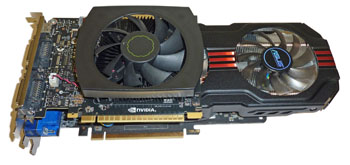Double the size
NVIDIA's GeForce GTX 650 Ti graphics card took centre stage for last week's editorial coverage. This new GPU, priced from £115, represents a solid investment for readers looking to purchase a card to play the latest games at a full-HD, 1,920x1,080 resolution that's common on most LCD monitors sold today.
The reference card, measuring just 5.65in long and consuming no more than 105W under load, paves the way for NVIDIA's add-in card partners to construct small, elegant cards that are just at home in HTPCs as in mainstream gaming rigs. The enviable power-draw characteristics also open up the possibility of passively-cooled cards, too.
The first retail-boxed card to pass through the office is the ASUS GeForce GTX 650 Ti Direct CU II TOP 1GB. The Taiwanese giant firmly eschews any notion of creating a small, sleek GTX 650 Ti card and, instead, focusses on performance. Take a look for yourselves.
Yup, that's a GeForce GTX 650 Ti card, though, on first glance, it looks far more like a GeForce GTX 680. This behemoth measures 11in from tip to toe, making it, therefore, practically twice as long as the reference card. It becomes difficult for us to understand the rationale behind such a release, as the GTX 650 Ti GPU, irrespective of whether it's overclocked to the hilt, is no match for the next model up, a bone-stock GTX 660.
ASUS lists three GTX 650 Ti cards in its arsenal, of which two feature the huge heatsink on show here. That said, with such a heatsink on a truly mainstream card, cooling and noise - or lack, thereof - should be stellar.
Focussing on the cooler, and how can you not when it stares you in the face, shows it uses a couple of 80mm fans that are, in fact, different to one another. The left-hand fan, located above the actual GPU, has nine blades while the right-hand fan uses 11. There's a considerable heatsink overhang from the PCB and such is the tight fit between cooler and board-mounted 6-pin PCIe connector, that it's rotated 180° and faces downwards.
Build quality is very good - the ASUS card feels much more like a premium product than NVIDIA's reference card. Making use of the heavy-duty cooler, ASUS increases the core clock from 925MHz to 1,033MHz, helped by, the company says, its DIGI+ VRM technology that offers better voltage control at overclocked speeds.
Missing a trick, however, the memory speed is left at 5,400MHz... and you'll see why this is a noisome oversight later on in the review.
Flipping her over shows the three thick heatpipes visually jutting out from the PCB. The top of the back also has the familiar ASUS frame that lends rigidity to the board. The usual SLI finger is conspicuous by its absence - the GTX 650 TI doesn't support NVIDIA's multi-GPU technology at all.
GTX 650 Ti supports up to four video outputs (the reference card ships with three). We fully understand the two dual-link DVI and full-size HDMI but the extra VGA seems like an anachronistic addition; we'd have preferred to see the all-digital DisplayPort present instead.
The bare PCB carries 1GB of GDDR5 memory that's identical to the reference card's. Going by previous overclocking experience, this means it should overclock to some way past an effective 6,000MHz.
Oh, and remember that we said it was somewhat larger than the reference card? Take a look to the right for confirmation.
The ASUS GeForce GTX 650 Ti Direct CU II TOP 1GB is set to retail for a whopping £160, or a £35 premium over the cheapest cards based on the same GPU. Overclocked on the core and cooled by a massive heatsink, it needs to comfortably beat the reference card in every way for it to be worthy of consideration.















